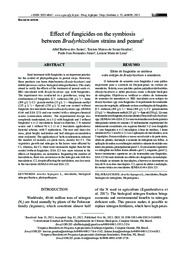Effect of fungicides on the symbiosis between Bradyrhizobium strains and peanut.
Effect of fungicides on the symbiosis between Bradyrhizobium strains and peanut.
Autoria: SANTOS, A. B. dos; GONDIM, T. M. de S.; FERNANDES JUNIOR, P. I.; LIMA, L. M. de
Resumo: Seed treatment with fungicides is an important practice for the control of phytopathogens in peanut crops. However, these products can harm rhizobacteria (Bradyrhizobium) and inhibit processes such as biological nitrogen fixation. This study aimed to verify the effects of the treatment of peanut seeds cv. BR1 inoculated with Bradyrhizobium spp. with fungicides. The experiment was conducted in a greenhouse, using two combinations of fungicides [C1: carboxin (200 g L-1) + tiram (200 g L-1); C2: pyraclostrobin (25 g L-1) + thiophanate methyl (225 g L-1) + fipronil (250 g L-1)] and one control without fungicide; two inoculants based on Bradyrhizobium spp. (SEMIA 6144 and ESA 123) and one control with a nitrogen chemical source (ammonium nitrate). The experimental design was completely randomized, in a 3 (2 with fungicide and 1 without fungicide) x 4 (2 inoculations based on rhizobia, 1 N mineral source and 1 without N) x 2 (1 or 2 inoculants applications) factorial scheme, with 5 replications. The root and shoot dry mass, plant height, nodulation and leaf nitrogen accumulation were evaluated. The application of both combinations reduced the number of nodules on plant roots, mainly for C1. The vegetative growth and nitrogen in the leaves were affected by C1, whereas, for C2, there were increments higher than for the control without fungicides. ESA 123 was more tolerant to the effects of fungicides on nodulation. Regarding the number of inoculations, there was an increase in the nitrogen rate with two inoculations. C2, despite affecting the nodulation, was less toxic to the inoculants SEMIA 6144 and ESA 123.
Ano de publicação: 2021
Tipo de publicação: Artigo de periódico
Unidade: Embrapa Algodão
Palavras-chave: Amendoim, Arachis Hypogaea, Bradyrhizobium, Estirpe, Fitopatógeno, Fixação biológica de nitrogênio, Fungicida, Fungicides, Fungo, Inoculante, Peanuts, Semente
Observações
1 - Por padrão são exibidas publicações dos últimos 20 anos. Para encontrar publicações mais antigas, configure o filtro ano de publicação, colocando o ano a partir do qual você deseja encontrar publicações. O filtro está na coluna da esquerda na busca acima.
2 - Para ler algumas publicações da Embrapa (apenas as que estão em formato ePub), é necessário ter, no celular ou computador, um desses softwares gratuitos. Sistemas Android: Google Play Livros; IOS: iBooks; Windows e Linux: software Calibre.
Acesse outras publicações
Acesse a Base de Dados da Pesquisa Agropecuária (BDPA) para consultar o acervo completo das bibliotecas da Embrapa.

